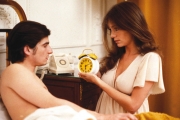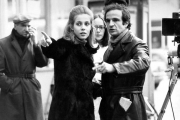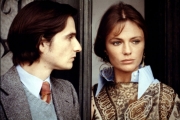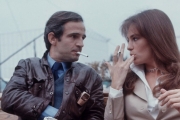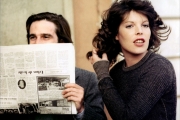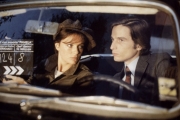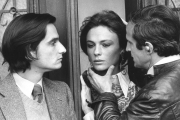![]() Presentation by and discussion with cinematographer Pierre-William Glenn and stunt coordinator Rémy Julienne
Presentation by and discussion with cinematographer Pierre-William Glenn and stunt coordinator Rémy Julienne


In Day for Night, Truffaut answers the question which intrigues all film lovers: How does one go about making a film? Day for Night is the story of the making of a film with two interlocking plots:
• the main story-line, recounting the adventures of a film crew, their professional and intimate dissensions while engaged in the process of filmmaking.
• the scenario of the film-within-the-film: a newly married man comes to the French Riviera to introduce his bride to his parents, leading to a series of complications.
Cast & Crew
Director • François Truffaut
Screenwriters • François Truffaut, Jean-Louis Richard, Suzanne Schiffman
Cinematographer • Pierre-William Glenn
Producer • Marcel Berbert
Starring :
Jacqueline Bisset, Valentina Cortese, Jean-Pierre Aumont, Jean-Pierre Léaud, Nathalie Baye, François Truffaut…

// 35mm copy provided by the British Film institute //
Choose a picture to see the filmography (source : IMDB)
![]()
How did you choose the title for this film, Day for Night?
Day for night is a film about cinema, about the making of a movie. It chronicles the creation of a film from the first day of shooting until the day the crew disbands. It was therefore necessary that the title make a reference to cinema, even if the expression is not well known. And since titles like Lights! or Camera, Action! have been used and abused of, we needed to find something else, and Day for Night also had a nice ring to it, even if its meaning was not widely understood.
Day for night is a cinematic term designating a shot that is filmed in broad daylight but whose resulting image on the screen gives the impression of nighttime. To put it another way, a filter is placed in front of the camera, on the lens. That is what the French call “nuit américaine” (American night), although curiously, Americans never referred to it as such.
Do you think you successfully depicted all aspects of film making in this film?
I do not think that the film really says the whole truth about cinema, because that would be very difficult to achieve, but I believe the film only speaks about things which are true, simply, evidently, but not fully. That is to say that since the film has been completed, I am constantly thinking of things that were unfortunately not included in the film. And so I know that I have enough material for another film, but one cannot make two films on a topic like this, not so close to one another. But I think that this theme will resurface very often in the coming years, because it is part of modern life.
Did you have an exact idea of the actors that you wanted to cast before you started to work on this project?
I wrote this film especially for some of the actors. I knew from the beginning that I would cast Jean-Pierre Léaud, as well as Jacqueline Bisset because I had seen her in American films, and Jean-Pierre Léaud because I had already written for him. They were the original actors, along with Jean-Pierre Aumont. For Valentina Cortese, I was not totally decided on the actress I would cast in my film. Therefore, I greatly took her reactions into account. She is a woman with remarkable creativity, a beautiful kind of creativity because it is generous; not selfishly prone to make the character look more prestigious. On the contrary, she has a satirical kind of creativity, often turned against her. A baroque creativity one might say.
How did you approach the character of Julie Baker as portrayed by Jacqueline Bisset?
I have had a certain experience filming with English actresses, and Jacqueline Bisset in this film is a bit of a combination of all of the English women with whom I have worked. Mostly the two actresses casted in Two English Girls and Julie Christie whom I directed in Fahrenheit 451. Jacqueline Bisset came with the advantage of having worked in Hollywood, so she brought some of that mythology along with her.
When Ferrand, the director you portray, says “Anyway, the cinema is always more important than life,” is it the character speaking or is it François Truffaut?
I think that a phrase, a scene like that, that revolves around the question of knowing whether life is more important – or in other words, if private life does not seem rather lame compared to professional life when you have the chance to do the job you have chosen to do – I think these are terms that must be dealt with when making a film on this topic. As in the plays of Pierre Angelo and Anouilh for instance.
I do not have any opinion about this. I just wanted to let everyone express themselves a bit in this story. What I do believe is that a director truly feels this, at least during the filming. It is true that, once on the set, the film becomes the main priority and it takes over everything, at the obvious expense of one’s private life, and eventually one’s family life.
Adapted from the interviews with François Truffaut on June 8, 1973(“Pour le cinéma” show), and on May 10, 1986 in Cannes –Images from the archive of the Institut National de l’Audiovisuel.
What did you gain from your experience working with Truffaut?
François’ connection to Cinema was very similar to mine. We were asking ourselves the very same questions: Why tell stories? Why fictional? François would say: « What really bothers me is the popular saying “When you love life, you go to the movies”. Personally, if I loved life, I would not go to the movies ». This idea of full commitment to fiction, to the desire to tell oneself stories and be happy with the stories we told on a giant screen, was something we had in common. To watch him bring all this to life and film it in Day for Night was essential for me. The relationships within the team were explosive. All crew members had dual roles: they had acting parts in the film, as well as real technical responsibilities. Except for me, the director of photography, who can only be seen briefly, on a motorcycle, in a long shot at the end of the movie. Thus, Walter Bal, who was my assistant, was interpreting the role of the director of photography in the film-within-the-film. He would often focus my camera only to jump in front of it (within the camera’s frame) to play his part in the film. The actual connection with reality was the camera that kept shooting, but the team had to keep playing their part. This cinema life, this dreamlike life, much more important than “real life”, was essential to Truffaut.
Another film was being shot at the same time at the Studios de la Victorine: The Last of Sheila, starring Raquel Welsh and James Coburn and directed by Herbert Ross – which no one ever heard of. We thus had a direct connection with American studio-cinema. We were shooting a small-scale French film with only six vans while they had a two mile line of cars at their disposal. And yet, Day for Night became the popular success we all know it to be. Our little team was very reminiscent of circus communities and nomadic travelers, whom Truffaut loved – it was his Gypsy side, the Jean-Pierre Léaud of The 400 Blows’ side, the resistant to establishment’s side, the right-wing anarchist Truffaut has always been. Cinema, as it was depicted in Day for Night, was nothing like the way I thought cinema was actually practiced at the time, but it was Truffaut’s cinema. What is so extraordinary is that it then came to embody French cinema around the world. One should always beware of the idea of realism. Day for Night also changed my own understanding of beauty and of the ways cinematography brings forth aspects of the world. It made me realize that you can film well only what you truly love. The secret of beauty in cinema is that it resides in the way one looks at the world: beauty is nowhere but in the eye. This cinematic potency retains much of its mystery. With François, I discovered just how much magic and irrationality there is in this matter.
How was Truffaut on the set?
Oddly enough, Truffaut had a studio mind-set. When shooting in natural settings, he would do everything to make it seem like a studio shoot. He hated both the notion of a crowd and of a documentary. Wherever we filmed had to become a protected cinematic space: it was not open, as in Wiseman’s films for example. Moreover Truffaut was not the type to wait for three days and rehearse for one day for a methodically organized twenty-minute take, as Terrence Mallick does.
I have worked with several unpleasant directors who need conflict on the set: if all goes well, they think the film is not doing well. Godard is typically a man who thrives on conflict and needs an expiatory victim on the set. That makes everyone a little uncomfortable and puts you in the guilt-ridden position of someone refusing to help the “person in danger”. For Truffaut, on the contrary, the set was a living place: everything had to be done with tenderness, love and desire. If some need conflict to create, he, on the contrary, was paralyzed by it. He hated shouting and arguments. He would often say he preferred hypocrisy to violence. It was not my style, but between us, it was still a beautiful match …
French New Wave directors like Truffaut, Rivette or Lelouch had a vital need for the collective energy of the shooting set. Some would live only for it, to the extent of being half-dead when not shooting. Others would consider it as an unpleasant moment to get through; only the end-result would matter for them, the celluloid which they can manipulate, cut and recompose within the safety of the editing room. François lived for the shooting of his films. It was, for him, an intense moment of life. The set was not a real place, but an enclosed space which pertained to magic, a living place, as was his office. He was at home there. His family was Christian Lentretien, Marcel Berbert and Suzanne Schiffman, who, in my opinion, was more of a co-director than an assistant. At the Films du Carosse, one felt like one had just entered an apartment, not a production office.
Interview conducted by Serge Toubiana and Florence tissot on April 4th, 2015 –taken from François Truffaut, published by Flammarion and La Cinénathèque Française
Chicago Sun Times
“Truffaut knows and loves the movies so much he is infectious; one of Day for Night’s best scenes is a dream in which the adult director remembers himself, as a little boy, slinking down a darkened street to steal a still from “Citizen Kane” from in front of a theater. We know who the little boy grew up to be, and that explains everything to us about how he feels now.”
Roger Ebert, September 7, 1973
The New York Times
“”As soon as we grasp things,” says Severine, “they’re gone.” In one way and another, almost all of Truffaut’s films have been aware of this impermanence, which, instead of making life and love seem cheap, renders them especially precious. […] Day for Night is Truffaut’s fondest, most compassionate film, and although it is packed with references to films and film people (Welles, Vigo, Fellini, Buñuel, among others) and although it is dedicated to Lillian and Dorothy Gish, it’s not a particularly inside movie. That is, it has great fun showing us how movies are made, how rain and snow are manufactured, how animals are directed (or not), how acts of God can affect a script, but its major concerns are people working at a profession they love, sometimes to the exclusion of everything else. […] In Day for Night, Truffaut is looking at the world from inside a glorious obsession: everyone outside looks a little gray and dim.”
Vincent Canby, September 29, 1973
Le Monde
« Film « à la première personne », La Nuit américaine l’est autant que Les Quatre cents coups. Lorsque le réalisateur de Je vous présente Pamela (rôle tenu par François Truffaut lui-même) revoit en rêve l’enfant qu’il a été, un gosse qui chapardait les photos d’acteurs affichées à la porte des salles, c’est évidemment un souvenir personnel qu’il évoque. Et lorsque Truffaut dit à Jean-Pierre Léaud : « Un film, c’est plus important que tout », on ne sait plus très bien si l’on est dans la fiction ou la réalité. Toute sa vie, François Truffaut a été fasciné par le cinéma. Ni les années ni la gloire n’ont altéré cette fascination. Elle vient de lui inspirer un de ses meilleurs films. »
Jean de Baroncelli, 16/05/1973
Le Figaro
« L’habilité de Truffaut tient à ceci qu’il n’accorde pas plus d’importance aux péripéties personnelles qu’aux péripéties inventées. Il ne cède jamais à la tentation de l’emphase. Il chasse les démons pirandelliens. Pour lui, tous les détails, vrais ou faux, s’identifient au même jeu, composent une seule histoire, grâce aux mystères de l’interférence.
Et voilà pourquoi La Nuit américaine restera comme la mieux accomplie des œuvres du genre. Les bons films de Truffaut sont d’ailleurs ceux qui reçoivent le meilleur et le plus secret de lui-même. Celui-ci dispense une sorte d’enchantement par les moyens les plus humbles et sans le moindre artifice d’émotion. Miracle de l’art pur. »
Louis Chauvet, 15/05/1973
Les Echos
« Présenté, à la demande du metteur en scène, hors concours à Cannes, il a rassuré ceux qui estimaient que la sélection française donnait une image « dégradante » de notre production. Rien de plus tendre, de plus pudique, de plus léger que cette comédie cinématographique. Avec, en prime, une promenade dans des « coulisses » qui, même pour les cinéphiles, restent souvent mystérieuses et dont Truffaut nous montre ici, tout simplement, la vraie vie. »
[S.N.], 04/06/1973
Le Canard enchainé
« Un film très public et très professionnel, un film réussi de bout en bout que je ne vous raconterai pas, mais qu’il faut aller voir. Un film français, enfin, réalisé avec esprit et légèreté. Le meilleur film de François Truffaut. »
M.D., 30/05/1973



